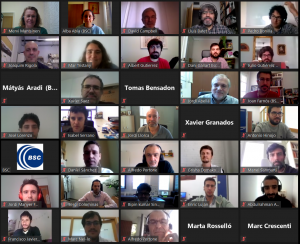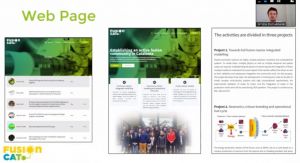The FusionCAT Annual Meeting 2020 took place today, and it counted with the participation of almost 40 researchers from different backgrounds, institutions and expertise. The main development areas of the project were explained and the current status of the ongoing research was presented. Comments, questions and constructive criticism were exchanged during the discussions, helping reach the overall conclusion that the FusionCAT project is progressing well and according to schedule. Each of the groups in the consortium achieved the technical objectives that were agreed upon, and, at the same time, participated in creating an active nuclear fusion community in Catalunya.
FusionCAT is a 3-year collaborative, EU funded project that aims to combine the knowledge, resources and efforts of the institutions working on the development of fusion technologies in Catalunya. It is a consortium formed by Foundation b_TEC Campus Diagonal-Besòs (BTEC), Technology Centre of Catalonia (EURECAT), Institute of Materials Science of Barcelona (ICMAB-CSIC), Chemical Institute of Sarrià (IQS), Catalonia Institute for Energy Research (IREC), and Universitat Politècnica de Catalunya (UPC). The Barcelona Supercomputing Centre (BSC) was chosen as coordinator of the project, and as such, it hosted and organized the FusionCAT Annual Meeting 2020 on Friday the 23rd of October.

Photo of attendees at the annual FusionCAT meeting
The meeting was held online via Zoom, and it took place between 9:30 and 16:00. It started with a welcome intervention by ICREA researcher, FusionCAT Coordinator and leader of the Fusion Research Department of the BSC, Prof. Mervi Mantsinen. This was followed by a short round of presentations of the participants, and an overview of the current status of the project by BSC Research Project Manager Ms Alba Abia. She applauded the effort of the project participants during this last year and said that “The Secretaria d’Universitats de Recerca de la Generalitat de Catalunya has congratulated us on our efforts and showed their interest and support of the project”. From there on, the meeting was divided into four parts (P1 to P4), corresponding to the main FusionCAT research projects, each of them, in turn, divided into tasks and subtasks.
The session on P1: Towards full fusion reactor integrated modelling was chaired by Prof. Mantsinen and started at 10:15. Dr Pedro Bonilla (BSC) began the presentations with a talk on the Development of fusion multiphysics HPC simulation capabilities, during which he pointed out that the next steps involved thermo-hydraulic coupling and validation, final 3D geometry and coupling with neutron transport. He was followed by Dr Dani Gallart (BSC) on the Experimental evaluation and validation of fusion simulation codes and Mr Jordi Manyer (BSC) on Code integration and applications in the ITER Integrated Modelling and Analysis Suite IMAS. Answering a question from a participant, Mr Dani Gallart explained that “The fusion group in the BSC tackle only experiments that take place in fusion reactors, such as JET, so they can be experimentally validated”. Each of the speakers had 15 minutes to present, after which another 15 minutes were dedicated to a discussion on Project 1.

Dr Pedro Bonilla (BSC) giving the presentation on the Development of fusion multiphysics HPC simulation capabilities.
Dr Joan Farnos (BSC) chaired P2: Neutronics, tritium breeding and operational fuel cycle. The first talk, on the Development of high fidelity deterministic neutron transport modelling, was given by Dr. Mantsinen, who then took questions and comments from the participants. The following speaker, Dr Jordi Abellà (IQS), talked about the Development of tritium and lithium sensors and fabrication of PbLi alloy. After him, Prof. Joaquim Rigola (CTTC) discussed High-fidelity CFD simulation of liquid metal flows, and Prof. Jordi Llorca (NEMEN) gave a presentation on the Catalytic membrane reactors for hydrogen isotope recovery and fuel clean-up systems. This segment again was closed by a 10-minute discussion on Project 2.

Dr. Mervi Mantsinen (ICREA-BSC) giving presentation on the development of high fidelity deterministic neutron transport modelling.
P3: Fusion reactor studies, chaired by b_TEC Head of Projects Mr Grisha Domakowski, started with presentations on HTS Magnets Development by Jose Lorenzo (BSC) and on Modelling, analysis and design of accelerator components for fusion materials research facilities by Mr Bipin Kumar (IREC), Dr Marc Crescenti (EURECAT) and Mr Daniel Sánchez (IREC). In his talk, Mr Daniel Sánchez explained that the next update of the International Fusion Materials Irradiation Facility (IFMIF), which would be oriented towards testing materials for DEMO, would start construction in Granada before the end of the project. During his side of the presentation, Mr Bipin Kumar expressed the need of a “Development of industrial partners for manufacturing of accelerator components for future projects“. They were followed by Prof. Lluís Batet (ANT) and Prof. Joaquim Rigola (CTTC) on the Dynamic modelling of Supercritical CO2 power cycles for fusion nuclear power plants aimed at the design of Control Systems. Dr Julio Gutierrez (BSC) closed the presentations with a talk on Large-scale modelling of fusion materials, highlighting the achievement of the firsts simulations on the atomic-level description of defects in crystalline tungsten bulk and surfaces.

Mr. Jose Lorenzo (BSC) giving a presentation on the HTS Magnets Development.
Finally, Prof. Mantsinen chaired P4: Dissemination and technology transfer, where the presentation was given by Grisha Domakowski (b_TEC), Alba Abia (BSC) and Joan Farnos (BSC), who had 20 minutes to talk about the topic of Project 4. Alba Abia and Grisha Domakowski discussed the website and social media aspect of the project, while Joan Farnos emphasised the importance of engaging with the greater fusion community, both public and private, and establishing synergies. Half an hour was then allocated for participants to take part in a general discussion, and Dr. Mantsinen took this opportunity to “Encourage everyone to keep the good work and contribute to the success of this project“.

Mr. Grisha Domakowski (b_TEC) giving the presentation on the FusionCAT dissemination actions.
The webinar is organized under the auspices of the FusionCAT project with reference number 001-P-001722 that has been co-financed by the European Union Regional Development Fund within the framework of the ERDF Operational Program of Catalonia 2014-2020, with the support of Generalitat of Catalonia.
![]()
![]()

